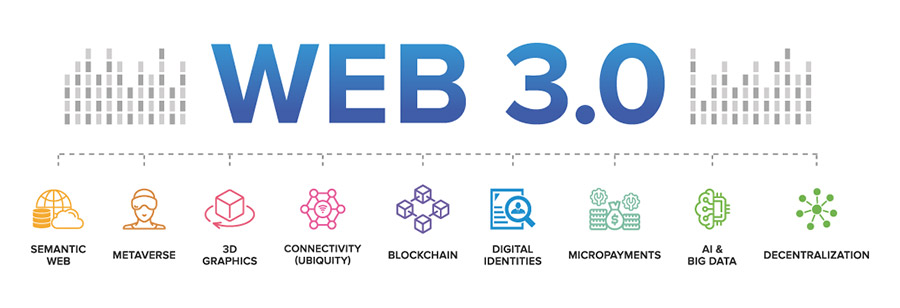Abstract
Regarding the name of SocialFi, it is the point that DeFi and the tumultuous world of social media come together. A SocialFi platform is the half-born of WEB3 and decentralization, and its essential elements such as creating, managing, and sharing content.
Introduction
When merging social media platforms with plenty of content, content creators, and influencers with decentralized Finance (DeFi) comes true, it will bring several benefits for content creators and users. Security, monetizing systems, freedom of speech, and more privileges of both approaches make this merging idea an ideal forward-moving action.
Social Media is Not a New Term in Our Life!
According to some traditions, the phenomenon dates back to the last century, when the “Six Degrees” began to work in the late 1990s.
The shared content on social media platforms is data, and data is valuable.
Using WEB2 is an interactive ecosystem where users exchange information, including their ideas, beliefs, and artwork. Those who give this space to users are the main winners who covertly enjoy this information.
In other words, how much the community becomes more significant, the platform attracts more advertising requests from big companies. The point is that this income can’t be as valuable as the processed data are precious.
The classified data will let the mother company of these platforms identify the users’ needs, appetites, and attitudes of the users, which will assist the corporations in planning their next steps.
SocialFi is based on WEB3. In comparison, web2 and web3 seem the same and founded social media platforms based on these two different generations. Still, there are several differences, including that in WEB2, users can write and read, while in WEB3, users create the content, own it, and manage it.

WEB3 has its financial system known as DeFi, which, less or more, we have all heard about it so far. The security in this newly unveiled world increased, the speed boosted, and many applications rose based on the decentralized infrastructures.
Social Media platforms contain precious data that essentially nobody can claim ownership of the data, and this ecosystem was highly insecure. With its highly secure nature, the blockchain industry came to help in the past couple of years. Little by little social media platforms have become a reliable and safe place for financial activities.
People trusted this system, and developers ply this opportunity to add financial platforms and expand their activities. Some of them are already popular with us, like Telegram, and others entitled themselves with the exact phrase “SocialFi.”
These social media platforms usually monetize the content using native network tokens or cryptocurrencies. Besides, NFTs have become more popular; some even have NFT airdrops.

1) SocialFi
SocialFi focused on solving key design issues around characteristics of Web2 social media platforms by sticking to Web 3.0 ethos and also has principles of social media and decentralized finance.
Users, especially content creators and influencers, are increasingly attracted to SocialFi platforms because they have better control of their data, freedom of speech, and the ability to monetize their social media following and engagement.
2) PeakD
PeakD is another SocialFi platform that many content creators offer an immersive blockchain experience and a decentralized content interaction.
The platform uses a blockchain key for user security and a password for accessing a user account. PeakD’s reward system generates votes on posts. Users will receive the reward in either platform’s tokens, HIVE and HBD, a Hive-backed dollar.
3) Ecency
Ecency is a social open-source blockchain-based networking platform that enables content creators and influencers to control the environment. The contents are immutable and uncensored; how much they engage more and create more content will receive more rewards.
4) ApolloFi
Another SocialFi project is ApolloFi which supports the Social-to-Earn model, designed for content creators based on Polygon, Ethereum, and BNB Chain. ApolloFi provides simple and convenient social tools for hundreds and thousands of users to build a free and diverse paradise for creators.
5) Nafter
Nafter is a SocialFi platform similar to Instagram and supports NFT content. Nafter is a place for creators to convert the created post into NFTs and sell the right to view the post for profit, while users can also pledge the platform’s native NAFT.
6) Coinvise
Coinvise allows developers to integrate tokens into their existing platforms. On Coinvise, creators or communities can mint social tokens on the Ethereum and Polygon networks. In contrast, creators can also use tokens for rewards, airdrops, crowdfunding, access control, NFT, and others.
7) Mask Network
The Mask Network is a decentralized, encrypted social messaging platform where users can send and receive cryptocurrency and share files on the network. Users may use the protocol to encrypt their Facebook and Twitter posts
8) Mirror
“Mirror.xyz,” is a content publishing platform focusing on articles and NFTs. Mirror.xyz can display text, images, videos, and embedded NFTs. When users publish an article, it automatically generates an NFT, stores it permanently in Arweave, and they also can trade it.
9) Hive Blog
Hive Blockchain has its platform, Hive Blog, and uses the cryptocurrency token HIVE. Hive tokens are collected in a community pool to reward users’ participation and contribution based on votes. Users who hold a higher quantity of these tokens as Hive power will be given priority in the reward pool distribution.
10) Rally
The Rally platform enables creators to launch and build their digital economy, facilitate connections with their fan communities and benefit from developing their ideas. It also lets users create and launch NFTs for free.
Problems that SocialFi Solves
In the era of Web 2.0, sizeable social network operators had complete control over the generated data by social network users. They use primary social data to profit, and users receive a little share in return. Hereunder, we will investigate the fundamental problems of traditional social networks in WEB2 that SocialFi intends to solve with the help of WEB3 and DeFi.
– Data Transparent and Unfalsifiable
Social media platforms collect and store created content and provide information by the users, own them and use them to make a profit with or without permission. SocialFi hopes to use blockchain technology to make user data sets transparent and unfalsifiable.
– Profit Distribution
Old-fashioned social media platforms make money by selling ads based on their users’ traffic. These systems make billions of dollars from more traffic and engagement when the only befits that users receive are using these platforms for free.
– Privacy and Security
In a traditional social network, all account registration requires the user’s information, including mobile phone number, email address, etc., stored in their central servers. SocialFi is a blockchain-based branch of technology that guarantees its users’ anonymity and keeps their identification information confidential, which helps them to protect their privacy and security of the contents they have created.
Conclusion
SocialFi is the common point between Web3 and social media platforms. Simply SocialFi is a social media platform launched on a blockchain network with all its financial components, security levels, and other benefits of the DeFi aspects to produce, control, and own user-generated content on platforms.
SocialFi content creators, influencers, and participants who want better control of their data let them have freedom of speech besides granting them the ability to monetize their social media following and engagement.
